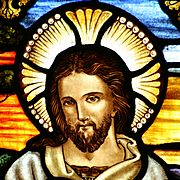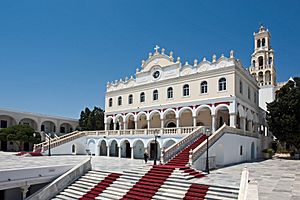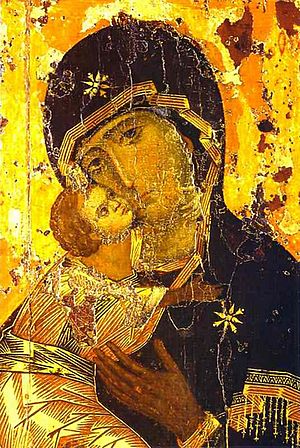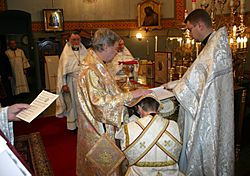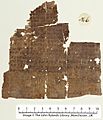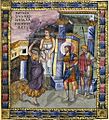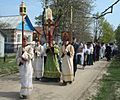Eastern Orthodox Church facts for kids
Quick facts for kids Orthodox Catholic Church |
|
|---|---|
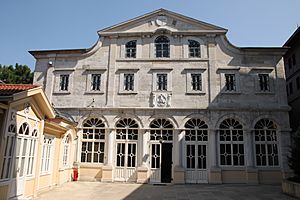
|
|
| Classification | Eastern Orthodoxy |
| Orientation | Eastern Christianity |
| Scripture | Septuagint, New Testament |
| Theology | Eastern Orthodox theology |
| Polity | Episcopal |
| Governance | Autocephaly |
| Structure | Communion |
| Primus inter pares | Bartholomew, Ecumenical Patriarch of Constantinople |
| Region | Worldwide, mainly Southeastern Europe, Eastern Europe, Northern Asia, Levant, Egypt, Northern America, Near East, Caucasia, Cyprus |
| Language | Koine Greek, Church Slavonic, and other vernacular |
| Liturgy | Byzantine Rite and Western Rite |
| Founder | Jesus Christ, according to sacred tradition |
| Origin | 1st century Judaea, Roman Empire |
| Members | 220 million |
| Other name(s) | Orthodox Church, Orthodox Christian Church, Orthodox Catholic Church |

The Eastern Orthodox Church is also known as the Orthodox Catholic Church or simply the Orthodox Church. It is the second-largest Christian church in the world. About 220 million people are members.
This church is a group of independent churches that work together. Each church is led by its own bishops and local councils called synods. Unlike the Catholic Church which has the pope as its leader, the Eastern Orthodox Church does not have one single leader. However, the Ecumenical Patriarch of Constantinople is seen as "first among equals" (primus inter pares). This title was once given to the leader of the Church in Rome. The Eastern Orthodox Church is one of the oldest religious groups still around. It has been very important in the history and culture of Eastern Europe and Southeastern Europe.
Eastern Orthodox beliefs come from the Bible and holy tradition. This tradition includes the decisions of the first seven major church councils and the teachings of early Church Fathers. The church believes it is the true church started by Jesus Christ. Its bishops are seen as the followers of Christ's apostles. It teaches that it practices the original Christian faith, passed down through history.
The church has seven main sacraments, which they call "holy mysteries." The most important is the Eucharist, also known as Holy Communion. In this service, the church teaches that bread and wine become the body and blood of Christ. The Virgin Mary is highly respected in the Eastern Orthodox Church. She is called the God-bearer or Mother of God.
Before the year 1054, the churches in Constantinople, Alexandria, Jerusalem, Antioch, and Rome were in full agreement. But in 1054, they split in what is called the East–West Schism. This happened because of growing disagreements about beliefs, politics, and culture. A big part of the disagreement was about the authority of the pope.
Today, the Eastern Orthodox Church is the main religion in countries like Russia, Ukraine, Romania, Greece, Serbia, and Georgia. Many Orthodox Christians live in countries that were once part of the Soviet Union. There are also Orthodox communities in North America, Western Europe, and Australia. These communities grew through people moving, converting, and missionary work.
What Orthodox Christians Believe
God is a Trinity
Eastern Orthodox Christians believe in the Trinity. This means there are three distinct divine persons: the Father, the Son (Jesus Christ), and the Holy Spirit. They are all one God, sharing the same divine nature. The Father is eternal and not created. The Son is eternal and born from the Father. The Holy Spirit is eternal and comes from the Father. These beliefs are summarized in the Nicene Creed.
Orthodox Christians believe in one God who is both far above the universe (transcendent) and also involved in it (immanent). They believe God's "uncreated energies" are how He connects with people. These energies are not separate from God, but are God Himself. The full nature of the Trinity is a holy mystery that people cannot fully understand.
Sin and Salvation
Orthodox Christians believe that when humans first sinned, human nature did not become evil. Instead, it became open to evil actions. People are "inclined to sin," meaning sinful things can seem attractive. However, Orthodox Christians do not believe that people are guilty of the original sin of Adam and Eve.
Since the first sin, humans could not fix their broken connection with God. So, God Himself had to change human nature. Orthodox Christians believe that Jesus Christ was both fully God and fully human. He was born of the Virgin Mary through the Holy Spirit. As a man, He died and went to the place of the dead. But because He was also God, death could not hold Him. He rose again, destroying the power of death.
Through Christ's victory over death, He opened the way to salvation for all good people who had died before Him. This includes Adam and Eve, who are remembered as saints in the church.
Jesus' Resurrection
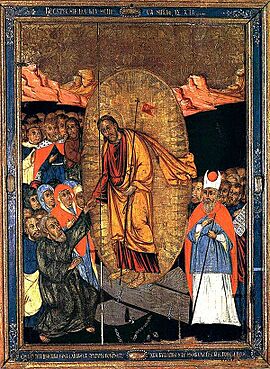
The Eastern Orthodox Church believes that Jesus' death and resurrection were real historical events. They happened just as described in the New Testament gospels.
Living a Christian Life
The church teaches that through baptism, Orthodox Christians begin a new life. This life is about turning away from sin and growing closer to God through the Holy Spirit. It is a spiritual journey where each person tries to be like Christ and pray constantly. This journey happens within the church, as part of the body of Christ. Through God's love, each person becomes more holy and more connected with Christ, both now and in the future.
The church believes that everyone is made in God's image and is called to become more like God. God offers each person a chance to share in His divine life by accepting His grace.
The Eastern Orthodox Church sees itself as the Body of Christ. This means the church includes all Christians, both those living on Earth and those who have passed into heaven. In Orthodox services, people on Earth worship God together with the saints and angels in heaven. This unity of the church is sometimes called the communion of the saints.
Monastic Life
Some Orthodox Christians choose to live a special life dedicated to God in monasteries. They follow rules like the Rule of St Benedict. These groups are similar to the Benedictine monks in the Catholic Church.
The Virgin Mary and Saints
The Eastern Orthodox Church believes that death is unnatural. It is a result of the first sin. They also believe that the church includes both the living and the dead. All people in heaven are considered saints. Some saints are especially known for being good examples. When a saint is officially recognized, a special service is held.
This service does not "make" someone a saint. It simply recognizes that they are one and announces it to the church. Saints are highly respected and loved, but they are not worshipped. Worship is only for God. By showing love to saints and asking for their prayers, Orthodox Christians believe saints help others on their path to salvation.
The most important saint is the Virgin Mary. She is called the Theotokos or Mother of God. This name shows that she gave birth to Jesus, who is fully God. Because of her special role, Mary is honored above all other saints.
The church believes that the bodies of saints are holy. This is because they participated in holy mysteries and the Holy Spirit lived within the church. Physical items connected to saints, like relics, are also seen as holy. The church teaches that God shows this holiness through miracles connected to these relics.
What Happens After Death
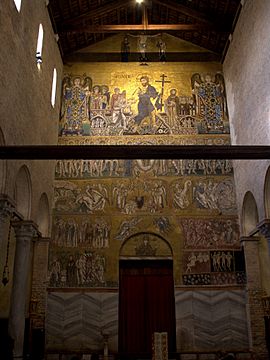
Orthodox Christians believe that when a person dies, the soul separates from the body. The soul then goes to a place of rest or a place of darkness, which is like a "foretaste" of what is to come. Orthodox Christians do not believe in Purgatory. This temporary state lasts until the Final Judgment, when the soul and body will reunite.
The church believes that the prayers of living Christians can help the souls of the dead until the Final Judgment. For this reason, special prayers are offered for the dead on certain days.
After the Final Judgment, Orthodox Christians believe:
- All souls will reunite with their resurrected bodies.
- Everyone will fully experience their spiritual state.
- Saints will continue to grow in their love for God forever, which means eternal happiness.
The Bible
The official Bible of the Eastern Orthodox Church includes the Septuagint version of the Old Testament. The New Testament uses the Patriarchal Text. Orthodox Christians see the Bible as a holy book that contains the basic truths of the Christian faith. These truths were revealed by Christ and the Holy Spirit to the human writers. The Bible is the main written source of holy tradition and is essential for all Orthodox teachings.
The Eastern Orthodox Church believes all the books in its Bible are valuable for reading and study. However, some books, like the four gospels, are held in higher regard. The church does not believe in sola scriptura (Bible alone), which some Protestant churches do. The church itself helps define what Scripture is and how to understand its meaning.
The Bible contains different types of writing, like history, poetry, and parables. The church encourages honest study of the Bible.
Church Services
Church Calendar
The church year follows different cycles. There is an annual cycle for feasts and fasts. There is also a weekly cycle. Each day of the week has a special focus:
- Sunday is for Christ's Resurrection.
- Monday honors angels.
- Tuesday is for prophets, especially John the Baptist.
- Wednesday is for the Cross and remembers Judas' betrayal.
- Thursday honors apostles and bishops.
- Friday is also for the Cross and remembers the Crucifixion.
- Saturday is for all saints and those who have died.
Music and Chanting
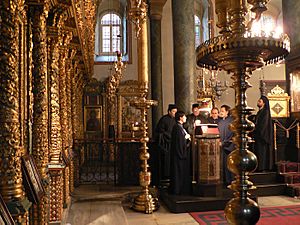
The church uses eight special musical modes or tones for chanting. The style of chanting can vary a lot between different cultures.
Traditions
Art and Buildings
Orthodox churches often have a unique architectural style. For example, the Archdiocesan Cathedral of the Holy Trinity in New York City is the largest Orthodox Christian church in the Western Hemisphere.
Local Customs
Orthodox churches often have names that show their country or region. For example, there are Russian Orthodox, Greek Orthodox, and Serbian Orthodox churches. This name can tell you what language is used in services and which bishops lead the church. In the Middle East, Orthodox Christians are sometimes called Rum Orthodox. This name comes from their historical connection to the Byzantine Empire.
Holy Mysteries (Sacraments)
In the Eastern Orthodox Church, what are often called "sacraments" in the West are known as "holy mysteries." While the Catholic Church names seven sacraments, the Orthodox Church does not limit the number. However, for teaching purposes, they often talk about seven main mysteries. These include Holy Communion, baptism, Chrismation, confession, unction (anointing with oil), matrimony, and ordination. Other sacred actions, like blessing holy water, are also considered mysteries.
Baptism
Baptism is a mystery that changes a person. The old, sinful self is washed away, and a new, pure self begins. All past sins are forgiven. Through baptism, a person becomes a member of the Eastern Orthodox Church. During the service, the person is fully dipped in blessed water three times. This symbolizes dying with Christ and rising to a new life with Him.
Bishops and priests usually perform baptism. However, in emergencies, any Eastern Orthodox Christian can baptize someone.
Chrismation
Chrismation (sometimes called confirmation) is a mystery where a baptized person receives the gift of the Holy Spirit. This happens by anointing them with holy oil called Chrism. It is usually done right after baptism, as part of the same service. It is also used to welcome back members who have been away from the church. Just as baptism connects a person to Christ's death and resurrection, Chrismation connects them to the coming of the Holy Spirit at Pentecost.
Once baptized and chrismated, an Eastern Orthodox Christian is a full member of the church. They can receive Holy Communion, no matter their age.
Holy Communion (Eucharist)
Holy Communion is given only to baptized and chrismated Eastern Orthodox Christians. They prepare for it through fasting, prayer, and confession. The priest gives the bread and wine directly into the person's mouth using a spoon. Even young babies and children receive Holy Communion after their baptism.
Marriage
For Orthodox Christians, marriage is one of the holy mysteries. It unites a woman and a man in a lasting bond of love before God. The goal is to follow Christ and raise a faithful family. The church teaches that marriage is between one man and one woman.
Jesus said that in heaven, people "neither marry nor are given in marriage, but are like angels" (Mark 12:25). Orthodox Christians understand this to mean that relationships in heaven will be spiritual, not just physical. The love between a husband and wife, which reflects the love between Christ and the church, is seen as eternal.
The church understands that sometimes couples must separate. However, it does not officially recognize civil divorces. For Orthodox Christians, marriage should not be broken.
Holy Orders
Only men can become priests or deacons. If a priest or deacon's wife dies, he cannot remarry. It is common for them to go to a monastery. This is also true for widowed wives of clergy; they often become nuns once their children are grown.
In 2016, the Church of Alexandria decided to bring back the role of deaconess. In 2017, Patriarch Theodoros II appointed five women as deaconesses in the Patriarchate of Alexandria.
Related pages
Images for kids
-
Emperor Constantine gives a model of Constantinople to Mary and baby Jesus in this church mosaic (Hagia Sophia, c. 1000).
-
An icon of Saint John the Baptist, 14th century, North Macedonia.
-
An early Christian "Ichthys" (fish) symbol from ancient Ephesus.
-
Icon showing Emperor Constantine and the bishops of the First Council of Nicaea (325) holding the Niceno–Constantinopolitan Creed of 381.
-
Hagia Sophia, once the largest church in the world and a very important church in Constantinople for nearly a thousand years.
-
The baptism of Princess Olga in Constantinople, a small picture from the Radzivill Chronicle.
-
Latin Crusaders attacking the city of Constantinople, the capital of the Eastern Orthodox Byzantine Empire, in 1204.
-
The oldest existing copy of the Nicene Creed, from the fifth century.
-
David glorified by the women of Israel from the Paris Psalter, an example of Macedonian art (Byzantine).
-
Fresco of Basil the Great, in the church of Saint Sophia, Ohrid.
-
Broken pottery vases on the street during a Holy Saturday tradition in Corfu.
-
The wedding of Tsar Nicholas II of Russia.
-
The consecration of Reginald Heber Weller as an Anglican bishop, with Tikhon of the Russian Orthodox Church present.
-
Pope Francis and Patriarch Bartholomew I in the Church of the Holy Sepulchre, Jerusalem, 2014.
-
Cathedral of Evangelismos, Alexandria.
-
Patriarchate of Peć in Kosovo, the main seat of the Serbian Orthodox Church since the 14th century.
-
A traditional Paschal procession by the Russian Orthodox Old-Rite Church.
See also
 In Spanish: Iglesia ortodoxa para niños
In Spanish: Iglesia ortodoxa para niños


